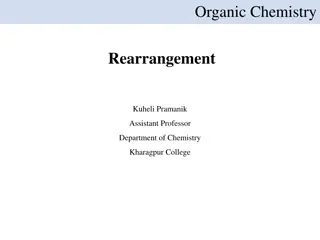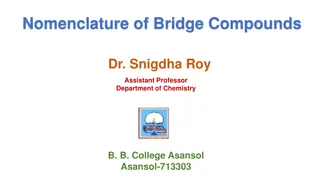Understanding Amines in Organic Chemistry: Structure, Nomenclature, and Importance
Amines are organic derivatives of ammonia with a nitrogen atom containing a lone pair of electrons, making them basic and nucleophilic. They play crucial roles in living organisms, such as being building blocks of proteins and constituents of nucleic acids. Learn about the structure, nomenclature, and significance of amines in the field of Organic Chemistry II. Dive into the diverse chemistry of amines and their relevance in biological systems.
Download Presentation

Please find below an Image/Link to download the presentation.
The content on the website is provided AS IS for your information and personal use only. It may not be sold, licensed, or shared on other websites without obtaining consent from the author. Download presentation by click this link. If you encounter any issues during the download, it is possible that the publisher has removed the file from their server.
E N D
Presentation Transcript
Name Dereje Mamo; and Addresses derejemamo.chem21@gmail.com Organic Chemistry II Chem-2042 UNIT TWO AMINES Prepared by DMT 1
2. AMINES 2.1. Introduction Amines are organic derivatives of ammonia in the same way that alcohols and ethers are organic derivatives of water. Like ammonia, amines contain a nitrogen atom with a lone pair of electrons, making amines both basic and nucleophilic. In fact, that most of the chemistry of amines depends on the presence of this lone pair of electrons. Amines occur widely in all living organisms. Trimethylamine, for instance, occurs in animal tissues and is partially responsible for the distinctive odor of fish, nicotine is found in tobacco, and cocaine is a stimulant found in the south American coca bush. Prepared by DMT 2
Cont In addition, amino acids are the building blocks from which all proteins are made, and cyclic amine bases are constituents of nucleic acids. Prepared by DMT 3
2.2. Structure and Nomenclature of amines 2.2.1. Structure of Amines The nitrogen atom of most amines is like that of ammonia; it is approximately sp3 hybridized. The three alkyl groups (or hydrogen atoms) occupy corners of a tetrahedron; the sp3 orbital containing the unshared electron pair is directed toward the other corner. We describe the molecular geometry/shape of the amine by the location of the atoms as being trigonal pyramidal. However, if we were to consider the unshared electron pair as being a group we would describe the electron-pair geometry of the amine as being tetrahedral. 4
Cont The bond angles are what one would expect of a tetrahedral structure; they are very close to 109.5 . The bond angles for trimethylamine, for example, are 108 . If the alkyl groups of a tertiary amine are all different, the amine will be chiral. There will be two enantiomer forms of the tertiary amine, and, theoretically, we ought to be able to resolve (separate) these enantiomers. Prepared by DMT 5
2.2.2. Nomenclature of Amines Amines can be either alkyl-substituted (alkylamines) or aryl- substituted (arylamines). Amines are classified as primary (RNH2), secondary (R2NH), or tertiary (R3N), depending on the number of organic substituents attached to nitrogen. Thus, methylamine (CH3NH2) is a primary amine, dimethylamine [(CH3)2NH] is a secondary amine, and trimethylamine [(CH3)3N] is a tertiary amine. 6
Cont Note that the usage of the terms 1 , 2 , and 3 amine are different from 1 , 2 , and 3 alcohol or alkyl halide, because 1 , 2 , and 3 alcohol or alkyl halide refer to the degree of substitution at the alkyl carbon atom, but in 1 , 2 , and 3 amine, we refer to the degree of substitution at the nitrogen atom. Prepared by DMT 7
Cont Compounds containing a nitrogen atom with four attached groups also exist, but the nitrogen atom must carry a formal positive charge. Such compounds are called quaternary ammonium salts. Primary amines are named in the IUPAC system in several ways. For example amines, the suffix amine is added to the name of the alkyl substituent. 8
Cont Amines with more than one functional group are named by considering the NH2 as an amino substituent on the parent molecule. Symmetrical secondary and tertiary amines are named by adding the prefix di- or tri-to the alkyl group. Prepared by DMT 9
Cont Unsymmetrically substituted secondary and tertiary amines are named as N-substituted amines. The largest alkyl group is chosen as the parent name, and the other alkyl groups are N-substituents on the parent (N because they are attached to nitrogen). Prepared by DMT 10
Cont The important heterocyclic amines all have common names. In systematic replacement nomenclature the prefixes aza-, diaza-, and triaza-are used to indicate that nitrogen atoms have replaced carbon atoms in the corresponding hydrocarbon. A nitrogen atom in the ring (or the highest atomic weight heteroatom, as in the case of thiazole) is designated position 1 and numbering proceeds to give the lowest overall set of locants to the heteroatoms: Prepared by DMT 11
Cont In a fused system, numbering should prefer (in this order): Ring with more nitrogen Ring with other heteroatom Larger rings Nitrogen atom close to ring junction Prepared by DMT 12
2.3. Properties of Amines: Physical and chemical properties 2.3.1. Physical properties of amines Amines are moderately polar substances; they have boiling points that are higher than those of alkanes, but generally lower than those of alcohols of comparable molecular weight. Molecules of primary and secondary amines can form strong hydrogen bonds to each other and to water. Molecules of tertiary amines cannot form hydrogen bonds to each other, but they can form hydrogen bonds to molecules of water or other hydroxylic solvents. As a result, tertiary amines generally boil at lower temperatures than primary and secondary amines of comparable molecular weight, but all low-molecular-weight amines are very water soluble. Prepared by DMT 13
Cont Table 1. lists the physical properties of some common amines Prepared by DMT 14
Cont All amines (1o, 2o & 3 ) form hydrogen bonds to water, accounting for their solubility (like dissolve like). One other characteristic of amines is that their odors, Low-molecular-weight amines, such as trimethylamine have a distinctive fishlike aroma/odor, while diamines such as 1,5-pentadiamine, commonly called cadaverine, have the appalling odors. Prepared by DMT 15
2.3.2. Chemical properties of amines They are weak bases and they can react with acids (forming salt). They react with water to produce alkylammonium ions and hydroxide anions. Prepared by DMT 16
2.4. Basicity of Nitrogen Compounds The chemistry of amines is dominated by the lone pair of electrons on nitrogen, which makes amines both basic and nucleophilic. They react with acids to form acid-base salts, and they react with electrophiles in many of the polar reactions. Prepared by DMT 17
Cont Amines are much stronger bases than alcohols and ethers, their oxygen-containing analogs. When an amine is dissolved in water, an equilibrium is established in which water acts as an acid and transfers a proton to the amine. Just as the acid strength of a carboxylic acid can be measured by defining an acidity constant Ka, the base strength of an amines can be measured by defining an analogous basicity constant Kb. The larger the value of Kband the smaller the value of pKb, the more favourable the proton-transfer equilibrium and the stronger the base. 18
Cont In practice, Kb values are not often used. Instead, the most convenient way to measure the basicity of an amine (RNH 2) is to look at the acidity of the corresponding ammonium ion (RNH 3+). 19
Cont These equations say that the Kb of an amine multiplied by the Ka of the corresponding ammonium ion is equal to Kw, the ion-product constant for water (1.00 x 10-14). Thus, if we know Ka for an ammonium ion, we also know Kb for the corresponding amine base because Kb = Kw/Ka. The more acidic the ammonium ion, the less tightly the proton is held and the weaker the corresponding base. That is, a weaker base has an ammonium ion with a smaller pKa, and a stronger base has an ammonium ion with a larger pKa. Weaker base Smaller pKa for ammonium ion Stronger base Larger pKa for ammonium ion Prepared by DMT 20
Cont Table 2. Lists pKa values of some ammonium ions and indicates that there is a substantial range of amine basicities. Most simple alkylamines are similar in their base strength, with pKa s for their ammonium ions in the narrow range 10 to 11. Arylamines, however, are considerably less basic than alkylamines, as are the heterocyclic amines like pyridine and pyrrole. Prepared by DMT 21
Cont 22
Cont In addition to their behaviour as bases, primary and secondary amines can also act as very weak acids because an N-H proton can be removed by a sufficiently strong base. Prepared by DMT 23
2.4.1. Basicity of Substituted Arylamines As notes previously, arylamines are generally less basic than alkylamines. Anilinium ion has pKa = 4.63 for instance, where as methylammonium ion has pKa = 10.64. Arylamines are less basic than alkylamines because the nitrogen lone- pair electrons are delocalized by interaction with the aromatic ring ?- electron system and are less available for bonding to H+. In resonance terms, arylamines are stabilized relative to alkylamines because of their five resonance forms. 24
Cont Much of the resonance stabilization is lost on protonation, however, so the energy difference between protonated and nonprotonated forms is higher for arylamines than it is for alkylamines. As a result, arylamines are less basic. Prepared by DMT 25
Cont Substituted arylamines can be either more basic or less basic than aniline, depending on the substituent. Electron-donating substituents, such as CH3, -NH2, and OCH3, which increase the reactivity of an aromatic ring toward electrophilic substitution, also increase the basicity of the corresponding arylamines. Electron-withdrawing substituents, such as Cl, -NO2, and CN, which decrease ring reactivity toward electrophilic substitution, also decrease arylamines basicity. Prepared by DMT 26
Cont Table 3. Considers only p-substituted anilines, but similar trends are observed for ortho and para derivatives. 27
2.4.2. Basicity of Heterocyclic Amines Nonaromatic heterocyclic amines have basicities that are approximately the same as those of acyclic amines: In aqueous solution, aromatic heterocyclic amines such as pyridine, pyrimidine, and pyrrole are much weaker bases than nonaromatic amines or ammonia. (In the gas phase, however, pyridine and pyrrole are more basic than ammonia, indicating that solvation has a very important effect on their relative basicities). Prepared by DMT 28
2.4.3. Amines versus Amides Basicities Amides are far less basic than amines (even less basic than arylamines). The pKa of the conjugate acid of a typical amide is about zero. The lower basicity of amides when compared to amines can be understood in terms of resonance and inductive effects. An amide is stabilized by resonance involving the nonbonding pair of electrons on the nitrogen atom. However, an amide protonated on its nitrogen atom lacks this type of resonance stabilization. This is shown in the following resonance structures: 29
Cont However, a more important factor accounting for amides being weaker bases than amines is the powerful electron-withdrawing effect of the carbonyl group of the amide. Comparing the following equilibrium, the reaction with the amide lies more to the left than the corresponding reaction with an amine. This is consistent with the amine being a stronger base than an amide. Prepared by DMT 30
2.5. Aminium Salts and Quaternary Ammonium Salts When primary, secondary, and tertiary amines act as bases and react with acids, they form compounds called aminium salts. In an aminium salt the positively charged nitrogen atom is attached to at least one hydrogen atom: Prepared by DMT 31
Cont When the central nitrogen atom of a compound is positively charged, but is not attached to a hydrogen atom, the compound is called a quaternary ammonium salt. For example, Prepared by DMT 32
Cont Quaternary ammonium halides because they do not have an unshared electron pair on the nitrogen atom cannot act as bases. Quaternary ammonium hydroxides, however, are strong bases. As solids, or in solution, they consist entirely of quaternary ammonium cations (R4N+) and hydroxide ions (OH-); they are, therefore, strong bases as strong as sodium or potassium hydroxide. Quaternary ammonium hydroxides react with acids to form quaternary ammonium salts: Prepared by DMT 33
2.6. Reactions of Amines 2.6.1. Alkylation and Acylation Alkylation of primary and secondary amines are difficult to control and often give mixtures of products, but tertiary amines are cleanly alkylated to give quaternary ammonium salts. Primary and secondary (but not tertiary) amines can also be acylated by nucleophilic acyl substitution reaction with an acid chloride or an acid anhydride to yield an amide. Not overacylation of the nitrogen does not occur because the amide product is much less nucleophilic and less reactive than the starting amine. Prepared by DMT 34
Cont C Prepared by DMT 35
2.6.2. Hofmann Elimination Like alcohols, amines can be converted into alkenes by an elimination reaction. Because an amide ion, NH2-, is such a poor leaving group, however, it must first be converted into a better leaving group. In the Hofmann elimination reaction, an amine is methylated by reaction with excess iodomethane to produce a quaternary ammonium salt, which then undergoes elimination to give an alkene on heating with a base, typically silver oxide, Ag2O. For example, 1-methylpentylamine is converted into 1-hexene 60% yield. Prepared by DMT 36
Cont Silver oxide acts by exchanging hydroxide ion for iodide ion in the quaternary salt, thus providing the base necessary to cause elimination. The actual elimination step is an E2 reaction in which hydroxide ion removes a proton at the same time that the positively charged nitrogen atom leaving. Prepared by DMT 37
Cont An interesting feature of the Hofmann elimination is that it gives products different from those of the most other E2 reactions. Whereas the more highly substituted alkene product generally predominates in the E2 reaction of an alkyl halide (Zaitsev s rule), the less highly substituted alkene predominates in the Hofmann elimination of a quaternary ammonium salt. The reason for this selectivity is probably steric. Because of the large size of the trialkylamine leaving group, the base must abstract a hydrogen from the most sterically accessible, least hindered position. Prepared by DMT 38
Cont Prepared by DMT 39
2.6.3. Electrophilic Aromatic Substitution An amino group is strongly activating and ortho-para directing in electrophilic aromatic substitution reactions. Thus high reactivity can be a drawback at times because its often difficult to prevent polysubstitution. For instance, reaction of aniline with Br2 takes rapidly and yields the 2,4,6-tribrominated product. The amino group is so strongly activating that its not possible to stop at the monobromo stage. Prepared by DMT 40
Cont Another drawback to the use of amino-substituted benzenes in electrophilic aromatic substitution reactions is that Friedel-Crafts reactions are not successful. The amino group forms an acid-base complex with the AlCl3 catalyst, which prevents further reaction from occurring. Both drawbacks can be overcome, however, by carrying out electrophilic aromatic substitution reactions on the corresponding amide rather than on the free amine. Prepared by DMT 41
Cont When we treat an amine with acetic anhydride yields the corresponding acetyl amide, or acetamide. Although still activating and ortho-para directing, amido substituents (-NHCOR) are less strongly activating and less basic than amino groups because their nitrogen lone-pair electrons are delocalized by the neighbouring carbonyl group. As a result, bromination of an N-arylamide occur cleanly to give a monobromo product, and hydrolysis with aqueous base then gives the free amine. Prepared by DMT 42
Cont For example, p-toluidine (4-methylaniline) can be acetylated, brominated, and hydrolysed to yield 2-bromo-4-methylaniline. None of the 2,6-dibrominated product is obtained. Prepared by DMT 43
Cont Friedel-Crafts alkylation and acylation's of N-arylamides also proceed normally. For example, benzoylation of acetanilide (N-acetylation) under Friedel-Crafts conditions gives 4-aminobenzophenone in 80% yield after hydrolysis. Prepared by DMT 44
2.6.4. Reactions of Amines with Nitrous Acid Nitrous acid (HONO) is a weak, unstable acid. It is always prepared in situ, usually by treating sodium nitrite (NaNO2) with an aqueous solution of a strong acid: Nitrous acid reacts with all classes of amines. The products that we obtain from these reactions depend on whether the amine is primary, secondary, or tertiary and whether the amine is aliphatic or aromatic. Prepared by DMT 45
2.6.4.1. Reactions of Primary Aliphatic Amines with Nitrous Acid Primary aliphatic amines react with nitrous acid through a reaction called diazotization to yield highly unstable aliphatic diazonium salts. Even at low temperatures, aliphatic diazonium salts decompose spontaneously by losing nitrogen to form carbocations. The carbocations go on to produce mixtures of alkenes, alcohols, and alkyl halides by removal of a proton, reaction with H2O, and reaction with X-: Prepared by DMT 46
2.6.4.2. Reactions of Primary Arylamines with Nitrous Acid The most important reaction of amines with nitrous acid, by far, is the reaction of primary arylamines. Primary arylamines react with nitrous acid to give arenediazonium salts. Even though arenediazonium salts are unstable, they are still far more stable than aliphatic diazonium salts; they do not decompose at an appreciable rate in solution when the temperature of the reaction mixture is kept below 5 C: Prepared by DMT 47
Cont Diazotization of a primary amine takes place through a series of steps. In the presence of strong acid, nitrous acid dissociates to produce +NO ions. These ions then react with the nitrogen of the amine to form an unstable N-nitrosoaminium ion as an intermediate. This intermediate then loses a proton to form an N-nitrosoamine, which, in turn, tautomerizes to a diazohydroxide in a reaction that is similar to keto enol tautomerization. Then, in the presence of acid, the diazohydroxide loses water to form the diazonium ion. Prepared by DMT 48
Cont Prepared by DMT 49
2.6.4.3. Reactions of Secondary Amines with Nitrous Acid Secondary amines both aryl and alkyl react with nitrous acid to yield N-nitrosoamines. N-Nitrosoamines usually separate from the reaction mixture as oily yellow liquids: Prepared by DMT 50























